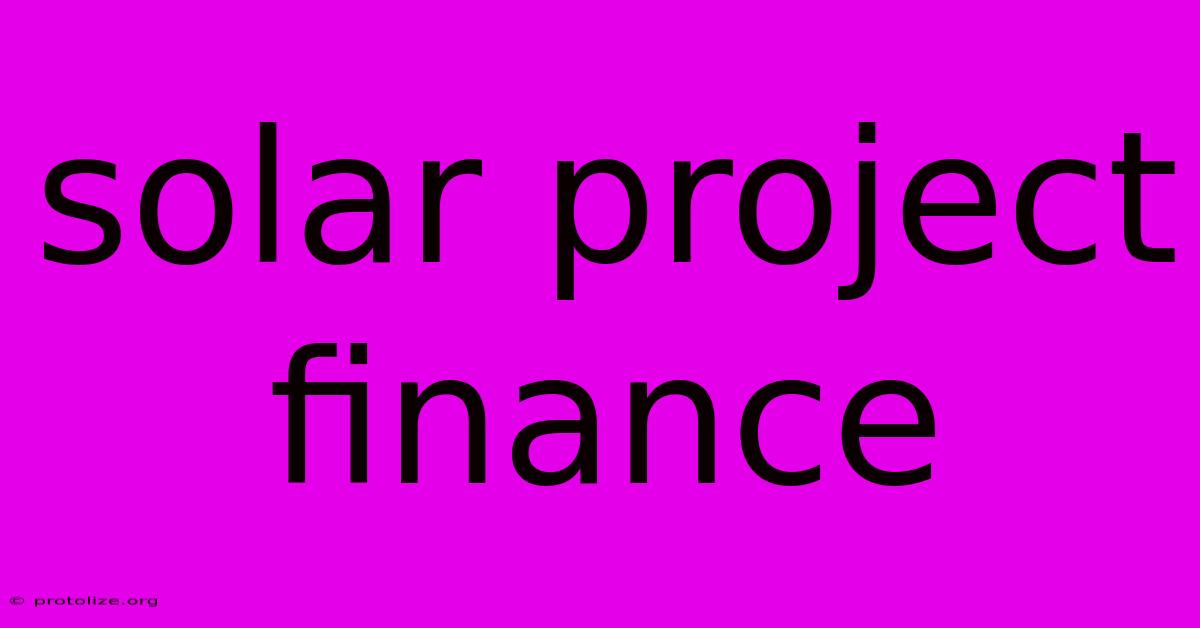Solar Project Finance

Discover more detailed and exciting information on our website. Click the link below to start your adventure: Visit Best Website mr.cleine.com. Don't miss out!
Table of Contents
- Solar Project Finance: Funding Your Path to Clean Energy
- Understanding the Financial Landscape of Solar Projects
- Key Financing Options for Solar Projects
- 1. Debt Financing
- 2. Equity Financing
- 3. Hybrid Financing
- Due Diligence and Risk Mitigation in Solar Project Finance
- Navigating the Solar Project Finance Process
Solar Project Finance: Funding Your Path to Clean Energy
The sun's energy is free, abundant, and increasingly accessible. However, harnessing that energy through solar projects requires significant upfront investment. This is where solar project finance comes in, playing a crucial role in making solar energy a viable and scalable solution for businesses and communities worldwide. This comprehensive guide explores the various financing options available, the key considerations for securing funding, and the overall process of navigating the financial landscape of solar energy development.
Understanding the Financial Landscape of Solar Projects
Solar project finance differs significantly from traditional commercial loans. The unique characteristics of solar projects – long lifespans, predictable energy production (with weather considerations), and government incentives – influence the types of financing available and the terms offered. Key factors influencing the financing process include:
- Project Size and Scope: Larger utility-scale solar farms require vastly different financing strategies compared to smaller residential or commercial installations.
- Technology: Different solar technologies (photovoltaic, concentrated solar power) have varying capital costs, operational expenses, and potential returns, impacting investor appeal.
- Location: Geographic factors such as solar irradiance, land costs, and regulatory environments significantly influence project feasibility and financing terms.
- Power Purchase Agreements (PPAs): PPAs, which guarantee a long-term revenue stream, are crucial in attracting investors and securing financing for larger projects.
- Government Incentives and Subsidies: Tax credits, grants, and renewable energy certificates (RECs) can dramatically reduce project costs and increase investor confidence.
Key Financing Options for Solar Projects
Several financing options cater to the diverse needs of solar project developers:
1. Debt Financing
- Conventional Loans: Secured by project assets, these loans offer predictable repayment schedules. Banks, credit unions, and other financial institutions provide these.
- Green Bonds: Debt securities specifically designed to finance environmentally friendly projects, including solar installations. These often attract investors seeking both financial returns and environmental impact.
- Project Finance Loans: Tailored financing solutions for large-scale solar projects, often involving multiple lenders and sophisticated structuring to manage risk.
2. Equity Financing
- Private Equity: Investments from private equity firms seeking long-term returns. This often involves significant upfront capital and a share in project ownership.
- Venture Capital: Investments from venture capital firms, typically focused on high-growth potential projects in the early stages of development.
- Crowdfunding: Raising capital from a large number of individual investors through online platforms. This approach is particularly suitable for smaller-scale projects.
3. Hybrid Financing
Often, a combination of debt and equity financing is employed to optimize the capital structure and mitigate financial risk. This approach leverages the strengths of both debt and equity funding to create a balanced financial strategy.
Due Diligence and Risk Mitigation in Solar Project Finance
Successful solar project financing requires meticulous due diligence and a robust risk management plan. Key aspects include:
- Technical Due Diligence: Assessing the technical feasibility and performance of the solar project, including site assessment, technology selection, and energy yield projections.
- Financial Due Diligence: Evaluating the project's financial viability, including revenue projections, operating expenses, and cash flow analysis.
- Legal and Regulatory Due Diligence: Ensuring compliance with all relevant laws, regulations, and permitting requirements.
- Environmental and Social Due Diligence: Addressing potential environmental and social impacts, including land use, biodiversity, and community engagement.
Navigating the Solar Project Finance Process
The financing process typically involves several key steps:
- Project Development: Developing a detailed project plan, including site selection, technology assessment, and regulatory compliance.
- Financial Modeling: Creating a comprehensive financial model to forecast project performance and attract investors.
- Investor Relations: Identifying and engaging with potential investors and lenders.
- Negotiation and Structuring: Negotiating financing terms and structuring the deal to minimize risk and maximize returns.
- Closing: Completing the financing transaction and commencing construction.
Solar project finance is a complex but rewarding field. By understanding the various financing options, conducting thorough due diligence, and navigating the financing process effectively, developers can unlock the immense potential of solar energy and contribute to a sustainable future. The increasing demand for renewable energy and supportive government policies create a favorable environment for investment in the solar sector, making it an exciting and impactful area of the financial world.

Thank you for visiting our website wich cover about Solar Project Finance. We hope the information provided has been useful to you. Feel free to contact us if you have any questions or need further assistance. See you next time and dont miss to bookmark.
Featured Posts
-
Personal Finance Advice Column
Dec 16, 2024
-
Volvo Certified Pre Owned Finance Rates
Dec 16, 2024
-
Security Finance Beloit Wi
Dec 16, 2024
-
Finance Rivian
Dec 16, 2024
-
Snap Finance Washer And Dryer
Dec 16, 2024
